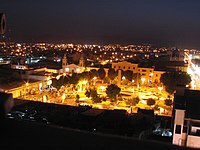Department of Ica
This article needs additional citations for verification. (August 2009) |
Ica
| |
|---|---|
 | |
|
Ica | |
| Government | |
| • Governor | Javier Gallegos Barrientos (2019–2022) |
| Area | |
| • Total | 21,327.83 km2 (8,234.72 sq mi) |
| Elevation (Capital) | 406 m (1,332 ft) |
| Highest elevation | 3,796 m (12,454 ft) |
| Lowest elevation | 0 m (0 ft) |
| Population (2017) | |
| • Total | 850,765 |
| • Density | 40/km2 (100/sq mi) |
| Dialing code | 056 |
| ISO 3166 code | PE-ICA |
| Principal resources | Iron, cotton, grapevine, kidney beans. |
| Website | www.regionica.gob.pe |
Ica (Spanish pronunciation:
Geography
The Department of Ica has a remarkable geography. It is the only region of the southern coast formed by plains, also called coast plains, since the
Ica's configuration is due to the
History
Ica has a rich history. The first settlers are from 10,000 years ago, from which the
cultures developed, the latter being the most important.The Paracas culture developed from the seventh through the 2nd century BC. It is distinguished by its matchless textile skills, trephinations, and the art of mummifying their dead.
The Nazca culture, on the contrary, well known for its artistic pottery, in which colorful designs and representations excel over the form, the same as their lines and figures that have undergone implausible interpretations. This culture expanded from the 2nd century BC through the 7th century AD. They have left us their wonderful aqueducts that made good use of underground water, of rivers and rain, showing a great knowledge of hydraulic engineering.
In the 15th century, during the
Years later, in 1563, with the arrival of the
During the independence war, General José de San Martín landed in Paracas and fixed his headquarters in Pisco, to start the fight for the independence of Peru.
Political division

The region is divided into five provinces (Spanish: provincias, singular: provincia), which are composed of 43 districts (distritos, singular: distrito).
Provinces
The provinces, with their capitals in parentheses, are:
Points of interest




City of Ica
Capital of the Ica Department. A very modern clean city that has Peruvian street markets, many old churches and landmarks, modern malls, hotels, coffee shops, theatres, and hotels as well.
Huacachina
Located on the west side of the city of Ica, capital of the Ica Department. One of the most popular places to visit in Ica is La Huacachina. The desert oasis is located 5 km (3.1 mi) from Ica. It is a small lake with medicinal water, lying in the middle of a spectacular sand desert.
Pisco
Pisco is the most important port in Ica and a litoral province. The most important attractions within this province are likely Paracas, Paracas Bay and the Paracas National Reserve. Pisco was home of an ancient pre-Hispanic culture, Paracas, who are known for their exquisite textiles.
Paracas
Nazca
The
They are even better known, however, for a unique set of creations known as the
Cachiche
A small village near Ica, Cachiche is well known for its history of witches. Doña Julia, Cachiche's first witch, was known to practice "good magic," curing and helping villagers with her spells. Near the entrance to the town, a carving from a single huarango tree [1] depicts this first "bruja de Cachiche" (witch of Cachiche).
Tourism
Ica has significant wine and pisco industries, annual fiestas, a museum and historic colonial churches.[2] The climate is generally sunny and dry due to its elevation above coastal fog and mist.[2] As of 2020, the Peruvian desert, around the Huacachina Oasis, has gotten significantly popular among tourists for sandboarding and sand buggy tours.
There is also a Regional Museum, which exhibits prehistoric artefacts as well as paintings and furniture that date back to the Spanish Colonial era. Moreover, in the museum, mummies with typical Paracas culture skulls can be found.[3]
See also
- 2007 Peru earthquake
- Lost City of Huayuri, Pre-Columbian archaeological site
- Pernil Alto, Pre-Columbian archaeological site
References
- ^ Peru Tours information
- ^ a b Ica Region from Lonely Planet Travel Guides and Information.. Retrieved August 2009.
- ^ "Tourism in Ica, Peru | Dos Manos". www.dosmanosperu.com. Retrieved 2021-05-07.
External links
- . Collier's New Encyclopedia. 1921.
